

 On the evening of
Sunday 26th January my best mate, Mark, drove me from London to the port of Felixstowe,
where I was scheduled to begin my 9 month Trans Africa expedition! I entered the P&O
Passenger Terminal and eagerly scanned the terminal for a likely looking crowd, sure
enough there was a small group with backpacks and sun hats! Our boat was due to set sail
for Zeebrugge, Belgium at 11.00pm, so I spent some time getting to know the group. It felt
strange to think I would be traveling with this group for 20 weeks overland from England
to Kenya! We boarded the ship and after a brief chat everyone decided to bed down. I soon
realized the tone of the trip when I discovered that our 'cabin' was actually the floor of
the lounge!
On the evening of
Sunday 26th January my best mate, Mark, drove me from London to the port of Felixstowe,
where I was scheduled to begin my 9 month Trans Africa expedition! I entered the P&O
Passenger Terminal and eagerly scanned the terminal for a likely looking crowd, sure
enough there was a small group with backpacks and sun hats! Our boat was due to set sail
for Zeebrugge, Belgium at 11.00pm, so I spent some time getting to know the group. It felt
strange to think I would be traveling with this group for 20 weeks overland from England
to Kenya! We boarded the ship and after a brief chat everyone decided to bed down. I soon
realized the tone of the trip when I discovered that our 'cabin' was actually the floor of
the lounge!
Our motley crew was made up of 6 English guys, 1 English girl, 1 Belgium guy, 2 Canadian girls, a Canadian couple, 1 Aussie guys, 2 Aussie girls, an Aussie couple, 1 Kiwi girl and the two expedition leaders. The group seemed reasonably balanced with a roughly equal number of guys and girls spread in the age group 21 - 35 years of age. On our routing down through Europe to Morocco the first stop was Paris. I was quite surprised to learn that -6 degrees Celsius was not considered extreme weather, so we were camping! This was the first of many disagreements I had with the trip leader.
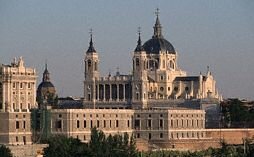 We took the route Paris - Bordeaux - San Sebastian -
Madrid - Costa del Sol - Gibraltar. It took us just over a week to get down to the port of
Algeciras, where we took the ferry across to Ceuta, a Spanish enclave on the Moroccan
coast. Over the week I got pretty friendly with Paula, one of the Canadian girls, and we
had quite a bit of fun exploring Madrid and staying out all night in Torre del Mar. For
some reason Paula and I had a sprinting race in Torre del Mar where my lead was abruptly
ended when I did a half flip across the bonnet of a car - quite dramatic!
We took the route Paris - Bordeaux - San Sebastian -
Madrid - Costa del Sol - Gibraltar. It took us just over a week to get down to the port of
Algeciras, where we took the ferry across to Ceuta, a Spanish enclave on the Moroccan
coast. Over the week I got pretty friendly with Paula, one of the Canadian girls, and we
had quite a bit of fun exploring Madrid and staying out all night in Torre del Mar. For
some reason Paula and I had a sprinting race in Torre del Mar where my lead was abruptly
ended when I did a half flip across the bonnet of a car - quite dramatic!
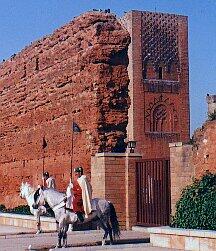 On 2nd February we arrived in Ceuta, Morocco and
began our trip proper on the African continent. It felt good to be away from the mid
winter European climate and on our way across the world's second largest continent. Our
first stop in Morocco was the charming coastal town of Asilah. The fortress like town was
riddled with narrow winding streets and white washed buildings. The people seemed
friendly and warm, however there were the typical insistent Moroccan guides who pursued
us. I had thought that these types of guys would have been limited to the big tourist
destinations. Next stop was the Moroccan capital, Rabat. Paula and I visited the main
medina and checked out the hundreds of tiny shops stocked with everything imaginable. The
huge variety of spices, grains and nuts caught my attention, as did the little tradesmen
shops for leather, carpets and bronze ware. We also had a walk around the Tour Hassan
(1195 AD) with its smartly dressed horseback guards.
On 2nd February we arrived in Ceuta, Morocco and
began our trip proper on the African continent. It felt good to be away from the mid
winter European climate and on our way across the world's second largest continent. Our
first stop in Morocco was the charming coastal town of Asilah. The fortress like town was
riddled with narrow winding streets and white washed buildings. The people seemed
friendly and warm, however there were the typical insistent Moroccan guides who pursued
us. I had thought that these types of guys would have been limited to the big tourist
destinations. Next stop was the Moroccan capital, Rabat. Paula and I visited the main
medina and checked out the hundreds of tiny shops stocked with everything imaginable. The
huge variety of spices, grains and nuts caught my attention, as did the little tradesmen
shops for leather, carpets and bronze ware. We also had a walk around the Tour Hassan
(1195 AD) with its smartly dressed horseback guards.
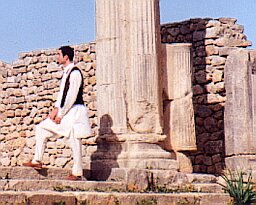 From Rabat we traveled to Fez via the Roman ruins of
Volubilis, built in the 1st century BC. For me the ruins were not really that impressive,
but they made a pleasant stop on our journey. The city of Fez was quite a highlight of
Morocco and it's culture. The old city and medina were built at the beginning of the 9th
century and used to be considered as the 3rd holy city of Islam. We stayed for a couple of
days and toured the Sultans Palace, Jewish Quarter, Jewish Cemetery, main medina and the
El Bali medina. For me the medinas were the real highlight, with the never ending
maze of winding narrow streets and every little cubbyhole containing an "industrial
unit". Despite the harsh Moroccan sun, much of the medina seemed almost dark due to
the overhanging houses hiding the sky. The medinas seemed to be a complete onslaught to
the senses, with the sights, the colors, the smell of spices, smoke from the charcoal
fires, the squalor, the sound of the little workshops and children playing etc.
From Rabat we traveled to Fez via the Roman ruins of
Volubilis, built in the 1st century BC. For me the ruins were not really that impressive,
but they made a pleasant stop on our journey. The city of Fez was quite a highlight of
Morocco and it's culture. The old city and medina were built at the beginning of the 9th
century and used to be considered as the 3rd holy city of Islam. We stayed for a couple of
days and toured the Sultans Palace, Jewish Quarter, Jewish Cemetery, main medina and the
El Bali medina. For me the medinas were the real highlight, with the never ending
maze of winding narrow streets and every little cubbyhole containing an "industrial
unit". Despite the harsh Moroccan sun, much of the medina seemed almost dark due to
the overhanging houses hiding the sky. The medinas seemed to be a complete onslaught to
the senses, with the sights, the colors, the smell of spices, smoke from the charcoal
fires, the squalor, the sound of the little workshops and children playing etc.
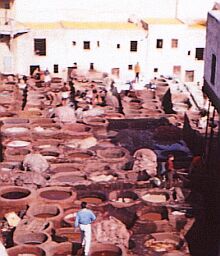
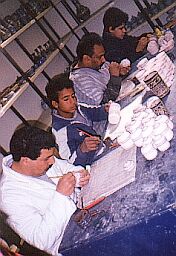 In Fez we visited a mosaic factory where we watched
the men and children painstakingly arrange the minute tiles to build the colorful mosaics.
We also toured a pottery and a huge tannery with colorful natural dye pits. The tannery
looked as though it must have been the same for hundreds of years and really made us feel
that we were looking back in time. It was fascinating to learn about all of the natural
dyes that were being used, but after 10 minutes or so the pungent stench of the dye pits
drove us away.
In Fez we visited a mosaic factory where we watched
the men and children painstakingly arrange the minute tiles to build the colorful mosaics.
We also toured a pottery and a huge tannery with colorful natural dye pits. The tannery
looked as though it must have been the same for hundreds of years and really made us feel
that we were looking back in time. It was fascinating to learn about all of the natural
dyes that were being used, but after 10 minutes or so the pungent stench of the dye pits
drove us away.
Being blond and female Paula drew allot of intention from the Moroccan men and I soon had to be quite protective. On one occasion while we were in a small store Paula walked into a section where I could no longer see her and then one of the guys tried to forcibly kiss her. In reality I seemed to draw their affection as well - a little more worrying!
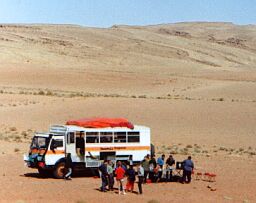 From Fez it was a full day's drive south along the
north side of the Middle Atlas mountains to the fascinating city of Marrakech. Marrakech
seem to have such an exotic reputation and we were all very keen to experience it. The
drive took us through some pretty varied countryside, from twisting alpine like roads to
baron desert like landscapes. For lunch we pulled off the road in the middle of nowhere
and set up a picnic on the sand. The 4 wheel drive truck certainly gave us freedom to stop
where ever we chose! Traveling on the truck also gave us a chance to see the countryside
away from the normal transport routes that we would have been restricted to had we been
traveling on public transport.
From Fez it was a full day's drive south along the
north side of the Middle Atlas mountains to the fascinating city of Marrakech. Marrakech
seem to have such an exotic reputation and we were all very keen to experience it. The
drive took us through some pretty varied countryside, from twisting alpine like roads to
baron desert like landscapes. For lunch we pulled off the road in the middle of nowhere
and set up a picnic on the sand. The 4 wheel drive truck certainly gave us freedom to stop
where ever we chose! Traveling on the truck also gave us a chance to see the countryside
away from the normal transport routes that we would have been restricted to had we been
traveling on public transport.
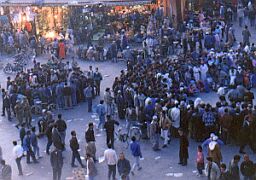
 Crowded with Arabs, Africans and Berbers, the old
city of Marrakech had a mystical air to it. At night we congregated in the famous square
of Djemaa El Fina with the snake charmers, story tellers, acrobats and street sellers. It
was a magical experience to sip mint tea and enjoy people watching at its best! The
ancient souks and the Djemaa El Fina square were intense and exhausting, so Paula and I
decided to spend the day at the world famous Mamounia Hotel. The hotel is regarded as one
of the best in the world and certainly the finest in North Africa. Winston Churchill
apparently spent months in this opulent hotel. Paula and I passed a long, peaceful
afternoon around the pool enjoying a sumptuous seafood buffet. The refinement of the
Mamounia seemed a universe away from the truck and crew.
Crowded with Arabs, Africans and Berbers, the old
city of Marrakech had a mystical air to it. At night we congregated in the famous square
of Djemaa El Fina with the snake charmers, story tellers, acrobats and street sellers. It
was a magical experience to sip mint tea and enjoy people watching at its best! The
ancient souks and the Djemaa El Fina square were intense and exhausting, so Paula and I
decided to spend the day at the world famous Mamounia Hotel. The hotel is regarded as one
of the best in the world and certainly the finest in North Africa. Winston Churchill
apparently spent months in this opulent hotel. Paula and I passed a long, peaceful
afternoon around the pool enjoying a sumptuous seafood buffet. The refinement of the
Mamounia seemed a universe away from the truck and crew.
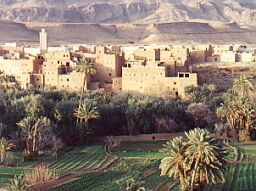 Next we had a very scenic drive over the High Atlas
mountains down to the spectacular Todra Gorge. On the journey we passed several
picturesque oasis towns built from mud bricks - one such town was Tinerhir. At Todra we
camped at the base of the gorge which was about 80m wide and a good 300m high. Paula and I
did a demanding 30km day trek up the gorge to the small village of Tamtatouchte. At the
village we were invited to drink tea with a friendly local family. On the trek we passed
herds of donkeys and camels.
Next we had a very scenic drive over the High Atlas
mountains down to the spectacular Todra Gorge. On the journey we passed several
picturesque oasis towns built from mud bricks - one such town was Tinerhir. At Todra we
camped at the base of the gorge which was about 80m wide and a good 300m high. Paula and I
did a demanding 30km day trek up the gorge to the small village of Tamtatouchte. At the
village we were invited to drink tea with a friendly local family. On the trek we passed
herds of donkeys and camels.
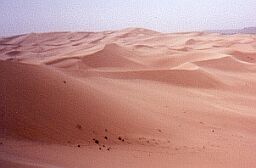 On 22nd February, my birthday, we crossed the border
into Algeria and camped on the outskirts of Taghit, an oasis town. The oasis blesses
Taghit with green fields and palm trees, but behind the town rise huge 150m high sand
dunes which form the edge of the Grand Erg Occidental. The endless, shifting sands of the
sand sea were how we all had imagined the Sahara! From Taghit we spent several days
driving south through thousands of kilometers of desert to In Salah and onto Tamanrasset.
On 22nd February, my birthday, we crossed the border
into Algeria and camped on the outskirts of Taghit, an oasis town. The oasis blesses
Taghit with green fields and palm trees, but behind the town rise huge 150m high sand
dunes which form the edge of the Grand Erg Occidental. The endless, shifting sands of the
sand sea were how we all had imagined the Sahara! From Taghit we spent several days
driving south through thousands of kilometers of desert to In Salah and onto Tamanrasset.
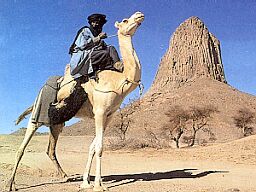 Tamanrasset, at a latitude of 22 degrees, is in the
extreme south of Algeria in the foothills of the majestic Hoggar Mountains. The well known
desert community is frequented by the noble Tuareg nomads. We were now deep in the heart
of the Sahara dessert. From Tamanrasset we hired Toyota Land Cruisers for a tour of the
Hoggar Mountains National Park. The tour was spectacular and we spent the night in the
secluded mountain hermitage of Pere de Foucauld. The morning sunrise against the pinnacles
of the Hoggar mountains was quite unforgettable.
Tamanrasset, at a latitude of 22 degrees, is in the
extreme south of Algeria in the foothills of the majestic Hoggar Mountains. The well known
desert community is frequented by the noble Tuareg nomads. We were now deep in the heart
of the Sahara dessert. From Tamanrasset we hired Toyota Land Cruisers for a tour of the
Hoggar Mountains National Park. The tour was spectacular and we spent the night in the
secluded mountain hermitage of Pere de Foucauld. The morning sunrise against the pinnacles
of the Hoggar mountains was quite unforgettable.
The general security situation in Algeria was slowly worsening and the next stretch of desert across the border into Mali was now supposed to be plagued with bandits. After much deliberation the trip leader finally decided it was too dangerous to attempt the crossing and we would have to find another way around! With heavy hearts we began to retrace a footsteps and head north to the Algerian capital of Algiers.
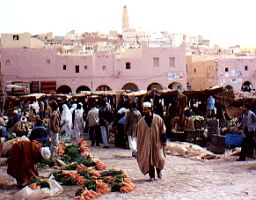 After a couple of days driving we arrived at the town
of Ghardaia, which is famous for its Mozabite people who follow an extreme Islamic
culture. The Mozabite women are totally veiled in black and are only permitted to show one
eye! The town was fairly untouched by tourism and we enjoyed browsing through the
authentic medina without the usual persistent 'guides'. The people seemed to take us in
their stride which made the whole experience far more rewarding. After another long day on
the road we arrived in the capital, Algiers, which was in a "State of
Emergency". The political unrest had led to the situation, but overall the city
seemed quite calm. Our trip leader forbid the group to enter the city, but I had other
plans!
After a couple of days driving we arrived at the town
of Ghardaia, which is famous for its Mozabite people who follow an extreme Islamic
culture. The Mozabite women are totally veiled in black and are only permitted to show one
eye! The town was fairly untouched by tourism and we enjoyed browsing through the
authentic medina without the usual persistent 'guides'. The people seemed to take us in
their stride which made the whole experience far more rewarding. After another long day on
the road we arrived in the capital, Algiers, which was in a "State of
Emergency". The political unrest had led to the situation, but overall the city
seemed quite calm. Our trip leader forbid the group to enter the city, but I had other
plans!
To me the trip seemed to be getting bogged down with the logistics of getting the truck down to Mali, so my plan was to fly. I worked out that flying to Mali would meant that I would be able to complete the trip and only miss the stretch of dessert from Tamanrasset in southern Algeria to Mopti in northern Mali - this loss would be insignificant. I realized that I would have to leave the trip and go it alone, but that seemed all the more exciting. Paula came to the same conclusion which was lucky as I probably wouldn't have left her - things were getting a little more serious between us!
Against the instructions of the trip leader Paula and I headed into the city to try an organize flights down to Mali. There was a definite tension in the air with a significant army presence and tanks on some streets. Paula, however, was intent on photographing the architecture and for this we ended up getting arrested for suspected espionage! Apparently there were army snipers etc. in some of the building that Paula had decided to photograph. We were hauled into a police station and questioned about our motives, luckily they believed us and we even got to keep the role of film!
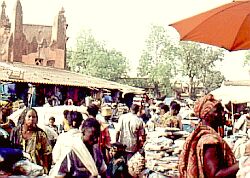 On Monday 9th March Paula an I flew from Algiers to
Bamako, the capital of Mali. We had arranged to keep in touch with the progress of the
overland tour via telex, with the aim of rejoining the group in Nigeria. We both
felt pretty nervous as the plane touched down in Bamako, we were on our own now! Mali is
one of the poorest nations in the world. It was dark as we rode a cab into the city
center, all we could see were small groups of people huddled around fires lit beside the
road. There seemed to be no high rise blocks in this city only shanty type buildings. We
managed to find a very basic hotel which was quite obviously a local brothel - but still
it was expensive!
On Monday 9th March Paula an I flew from Algiers to
Bamako, the capital of Mali. We had arranged to keep in touch with the progress of the
overland tour via telex, with the aim of rejoining the group in Nigeria. We both
felt pretty nervous as the plane touched down in Bamako, we were on our own now! Mali is
one of the poorest nations in the world. It was dark as we rode a cab into the city
center, all we could see were small groups of people huddled around fires lit beside the
road. There seemed to be no high rise blocks in this city only shanty type buildings. We
managed to find a very basic hotel which was quite obviously a local brothel - but still
it was expensive!
The prices in Mali seemed to be a complete anomaly, as the people were exceptionally poor but the prices seemed to be at an international level. The unrealistic prices were the product of the artificial pegging of the currency to the French Franc, also many people seemed not to be using currency but instead a bartering system! We had now left behind the Arab world of North Africa and were beginning our exploration of Black Africa. The saleswomen of the Grand Marché were a blaze of color with their coordinated body wraps and head scarves, the atmosphere at the market was very different to the souks of Morocco and Algeria. The climate here was also quite a contrast reaching a scorching 40 degrees almost everyday!
In Bamako we met a friendly guy called Mamoud, who enthusiastically guided us around the town for a few days. After considering our schedule carefully, we decided to invite him to be our guide for a week or so to visit the more interesting north of Mali. We drew up a little contract with Mamoud so that all parties would know what was included in his fee. We were due to leave for Mopti at 11.00am - the bus finally pulled out at 18.00! Transport in Mali is a real challenge to everyone's patients, especially when it is 40 degrees in the shade! After a long night with numerous prayer stops we finally pulled in to Mopti at 6.00am. Mopti, the 'Venice of Mali', is built on three islands at the confluence of the Niger and Bani rivers.

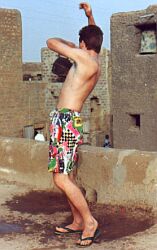 Mamoud immediately led us to the house of his
relatives where we would stay. The family lived in a simple adobe house and were warm and
friendly to us. Our washing facilities consisted of a kettle of water on the roof! At the
evening meal we all sat down together on the floor and ate with our hands out of a
communal bowl - I just prayed that my immune system was at 100%! For the night the family
gave us a couple of millet mats to bed down on the roof under the stars. The family
despite their obvious poverty oozed with generosity and enthusiasm to make our stay
pleasant.
Mamoud immediately led us to the house of his
relatives where we would stay. The family lived in a simple adobe house and were warm and
friendly to us. Our washing facilities consisted of a kettle of water on the roof! At the
evening meal we all sat down together on the floor and ate with our hands out of a
communal bowl - I just prayed that my immune system was at 100%! For the night the family
gave us a couple of millet mats to bed down on the roof under the stars. The family
despite their obvious poverty oozed with generosity and enthusiasm to make our stay
pleasant.
First Mamoud took us to see the Bella village built on the banks of the Niger river. The village consisted of small round mud huts that are washed away each year in the rainy season. The semi-nomadic, mostly Tuareg, inhabitants migrate back to the Timbuktu region at this time of year. Next we visited the impressive Grand Mosque. The large structure was built of mud and termite resistant Palm wood. The river seemed to be the center of activity with the trading boats, the dugout canoe ferry operators, and the people washing themselves and their goats.
We hired a pirogue, dugout canoe, to visit the Bozo village down river. The pirogue was punted across the huge river by the young owner who proudly called himself 'Captain'. The Bozo village was very picturesque with the mud built houses, the mosque in the center on a hill and the palm trees. As we landed at the village we were swamped by excited children buzzing around us like bees around honey. We really couldn't imagine how the village could have been any more primitive. Just as we had finished our tour of the village and were climbing back aboard our pirogue, one of the children came running up to me with my wallet that I must of dropped. I checked the contents of my wallet and was amazed that not a penny was missing!
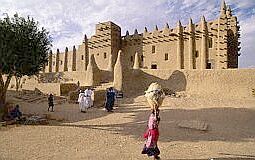 The next day we were
off to visit Djenné, the oldest and most impressive of the trading towns on the
Trans-Saharan caravan routes. We arrived at the stand to catch a pickup at 9.00am and
finally caught a ride at 2.00pm - apparently a reasonable wait in Mali! After four hours
of a bumpy road sitting on hard wooden benches we finally arrived in Djenné. Mamoud led
us directly to the house of another relative where we would spend the night. The Grand
Mosque here was even more impressive than the one in Mopti and Mamoud explained how after
the rainy season the local people repaired the mud structure.
The next day we were
off to visit Djenné, the oldest and most impressive of the trading towns on the
Trans-Saharan caravan routes. We arrived at the stand to catch a pickup at 9.00am and
finally caught a ride at 2.00pm - apparently a reasonable wait in Mali! After four hours
of a bumpy road sitting on hard wooden benches we finally arrived in Djenné. Mamoud led
us directly to the house of another relative where we would spend the night. The Grand
Mosque here was even more impressive than the one in Mopti and Mamoud explained how after
the rainy season the local people repaired the mud structure.
Next was our highlight of Mali, a 3 day trek to the Dogon villages around the Bandiagara cliff. The Dogon people have lived in this area since 500 BC and have retained their original animalist culture. Their mythology is the source of an abundance of sacred wood carvings, sculptures, masks and ancestral figures.
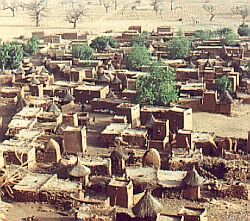
 First we had a 12km trek through scrub to the Dogon
village of Teli. The village was built on the flat at the foot of the Bandiagara cliffs.
Just above the village perching on the cliff face were the original houses that had been
used to hide from enemies. We took a rest to avoid the heat of the midday sun and had some
millet beer with the villagers. As normal we spent the night sleeping on a flat roof under
the stars. Despite the blistering heat of the day the nights were surprisingly cold, and
Paula and I had to huddle together to keep warm. The food was extremely basic but we
managed to get some extra calories by downing large amounts of sickly sweet condensed
milk!
First we had a 12km trek through scrub to the Dogon
village of Teli. The village was built on the flat at the foot of the Bandiagara cliffs.
Just above the village perching on the cliff face were the original houses that had been
used to hide from enemies. We took a rest to avoid the heat of the midday sun and had some
millet beer with the villagers. As normal we spent the night sleeping on a flat roof under
the stars. Despite the blistering heat of the day the nights were surprisingly cold, and
Paula and I had to huddle together to keep warm. The food was extremely basic but we
managed to get some extra calories by downing large amounts of sickly sweet condensed
milk!
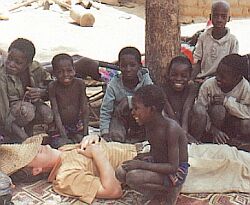
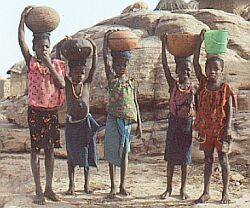 Over the 3 days we visited several Dogon villages
including Teli, Wilaya, Ende and Sonnengue. In Ende I ended up being 'school teacher' for
the morning. The Dogon people lived an incredibly primitive life - a universe away from
the Western World! We got to see the famous cliff side dwellings, some of the exotic
carvings, and the famous Dogon carved doors with intricate wooden locks, but the real
highlight were the seemingly untouched people!
Over the 3 days we visited several Dogon villages
including Teli, Wilaya, Ende and Sonnengue. In Ende I ended up being 'school teacher' for
the morning. The Dogon people lived an incredibly primitive life - a universe away from
the Western World! We got to see the famous cliff side dwellings, some of the exotic
carvings, and the famous Dogon carved doors with intricate wooden locks, but the real
highlight were the seemingly untouched people!
The trek back out of the Dogon country was a nightmare. Our guide wanted to hire donkeys at a ridiculous rate so we refused and decided to walk. We had a 17km trek across sand in a temperature of more than 40 degrees Celsius. It took us an exhausting 4 hours to reach the main road and the town of Bankass. We arrived severely dehydrated, there were times during the trek that we wondered whether we would make it! In Bankass we separated from our guide and were independent again. We couldn't find a hostel, but we managed to borrow a piece of foam and sleep out behind a bar! From Bankass we had another couple of days battle with Mali's transport system to get to the Border with Burkina Faso - Mali sure was a challenge to one's patience! After much deliberation we decided that the only way we were ever going to get to the border was to hire a taxi.
On 20th March we crossed the frontier between Mali and Burkina Faso at a remote border post. We only spent a few days in Burkina Faso, mostly in the capital Ouagadougou. Burkina Faso is situated in the never ending featureless sahel region, so we figured there wasn't really too much to see except the capital. We had a cool time in 'Ouaga', including spending the evening in a funky disco in the heart of town and getting a little carried away with the beer!
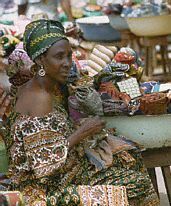 On 25th March, after a fairly tough two day bus
journey down from Ouagadougou, in Burkina Faso, we arrived in Abidjan, the capital of the
Ivory Coast. We headed directly to the Treichville suburb where most of the economy hotels
seemed to be situated. We soon discovered why this area was more commonly known as
'Trashville'. The suburb seemed a world away from the more glitzy CBD area of the city
which was just across the water. The hotels were pretty grungy, but it was late so we
decided to get one for the night. The neighborhood was dark and a little scary -
especially after a women came up to us and warned us that there was a good chance we would
get our throats cut by thieves! The hotel owner also begged us not to go out after dark,
fearing for our safety. Taking all the advice we decided not to stay out late and retreat
to the relative safety of our hotel, only to find that our room was infested with
cockroaches!. After quite an unpleasant night, the next day we swapped hotels and went up
market a little!
On 25th March, after a fairly tough two day bus
journey down from Ouagadougou, in Burkina Faso, we arrived in Abidjan, the capital of the
Ivory Coast. We headed directly to the Treichville suburb where most of the economy hotels
seemed to be situated. We soon discovered why this area was more commonly known as
'Trashville'. The suburb seemed a world away from the more glitzy CBD area of the city
which was just across the water. The hotels were pretty grungy, but it was late so we
decided to get one for the night. The neighborhood was dark and a little scary -
especially after a women came up to us and warned us that there was a good chance we would
get our throats cut by thieves! The hotel owner also begged us not to go out after dark,
fearing for our safety. Taking all the advice we decided not to stay out late and retreat
to the relative safety of our hotel, only to find that our room was infested with
cockroaches!. After quite an unpleasant night, the next day we swapped hotels and went up
market a little!
We decided that we would just spend a few days in Abidjan and the Ivory Coast before traveling on to Ghana - we had heard many good things about Ghana. We checked out the center of Abidjan which seemed a modern city with all of the normal amenities. Our highlight was a pool side seafood buffet at the Ivoire Hotel - supposedly the best hotel in West Africa. It was great to sit by the pool side, lit by oil lanterns and listening to live music - sometimes you just need a little luxury in Africa!
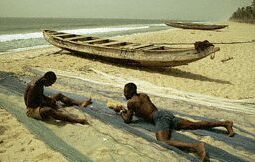 On 28th March we caught a 6.30am bus from the Ghana
State Transport Corp. bus terminal to Basua in Ghana. It felt very different traveling
through the lush tropical countryside after so much time in the desert and sahel regions.
Finally after a bureaucratic 4 hour border crossing we arrived at the beach town of
Basua just after sunset. Basua seemed calm and relaxed especially after the hustle and
bustle of Abidjan.
On 28th March we caught a 6.30am bus from the Ghana
State Transport Corp. bus terminal to Basua in Ghana. It felt very different traveling
through the lush tropical countryside after so much time in the desert and sahel regions.
Finally after a bureaucratic 4 hour border crossing we arrived at the beach town of
Basua just after sunset. Basua seemed calm and relaxed especially after the hustle and
bustle of Abidjan.
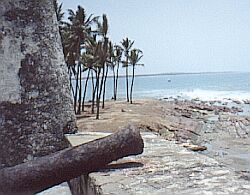 The people of Ghana seemed really friendly and laid
back, they also spoke English which was quite a treat after so much time in ex-French
colonies. Apart from the beaches, the real highlight of Ghana was visiting the infamous
slaving forts of Fort Metal Cross, Elmina and Cape Coast. The slaving forts built over 300
years ago were interesting but saddening. The dungeons where hundreds of slaves would be
crammed were inhumanely small and unventilated - the conditions must have been
unimaginably squalid. The slaves were kept in these conditions to 'break' them before they
were loaded onto the ships as cargo.
The people of Ghana seemed really friendly and laid
back, they also spoke English which was quite a treat after so much time in ex-French
colonies. Apart from the beaches, the real highlight of Ghana was visiting the infamous
slaving forts of Fort Metal Cross, Elmina and Cape Coast. The slaving forts built over 300
years ago were interesting but saddening. The dungeons where hundreds of slaves would be
crammed were inhumanely small and unventilated - the conditions must have been
unimaginably squalid. The slaves were kept in these conditions to 'break' them before they
were loaded onto the ships as cargo.
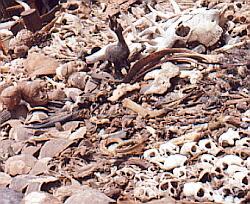 From the Ghanaian coast we headed inland up to the
Akosombo Dam which has formed one of the largest man made lakes in the world. We enjoyed
an interesting tour of the dam and then traveled to Kpalimé in Togo. We entered Togo on
3rd April and after spending a pleasant day in Kpalimé headed down to Lomé, the capital.
Togo is regarded as the heartland of voodooism, so we decided to visit the famous fetish
market in Lomé. The market was packed with bones, dried pieces of animals and other
talismans - quite eerie! Some of the skulls looked as though they could have been human!
We both agreed it would not be a good idea to upset anyone around the market, we didn't
fancy having a spell placed over us.
From the Ghanaian coast we headed inland up to the
Akosombo Dam which has formed one of the largest man made lakes in the world. We enjoyed
an interesting tour of the dam and then traveled to Kpalimé in Togo. We entered Togo on
3rd April and after spending a pleasant day in Kpalimé headed down to Lomé, the capital.
Togo is regarded as the heartland of voodooism, so we decided to visit the famous fetish
market in Lomé. The market was packed with bones, dried pieces of animals and other
talismans - quite eerie! Some of the skulls looked as though they could have been human!
We both agreed it would not be a good idea to upset anyone around the market, we didn't
fancy having a spell placed over us.
Next we crossed the border into Benin and traveled along the coast to the capital, Cotonou. From Cotonou we visited Ganvie, the largest and most beautiful of all lake villages in Africa. Inhabited by more than 10,000 people, it is built entirely on stilts in the middle of a lagoon. We caught a pirogue out to the village where we saw the people and their houses at close range. The colorful floating vegetable market was an interesting sight. Back in the capital we had a luxury day at the Sheraton and telexed the overland trip to arrange our rendezvous in Nigeria.
... Continued in next dairy - Africa (Part 2)
Churchill offer a range of excellent single and annual travel insurance options